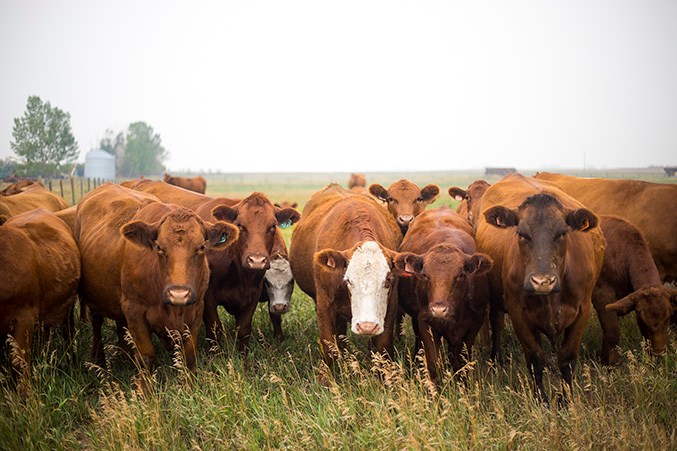A government-recommended healthy diet just got a new look, and this is one guide nutritionists believe Canadians have a hope of following, though the livestock and dairy industries expressed initial concern.
Health Canada released the newest version of Canada’s Food Guide earlier this month, the first update in over a decade.
The new guide focuses on broader categories and proportional servings instead of the often over-complicated serving sizes of past guides.
Foothills MP John Barlow said he has received more than 700 letters from healthcare officials expressing concern for the new food guide over the last two years.
Criticizing what he called an activist-bend in Health Canada, he claims the advice to reduce consumption of meat products is encouraging Canadians to make unhealthy food choices.
“I’ve had doctors tell me that you need those animal proteins to insure a healthy diet, and [Health Canada] has really gone out of their way to minimize that,” said Barlow.
The food guide, however, states protein found in plant sources is the same as the protein in meat, being a combination of amino acids.
Buckwheat, quinoa and soy offer complete proteins like meat, while other plant sources need to be combined.
The benefits to choosing plant protein over meat is merely to increase fibre and reduce saturated fats, according to the guide.
Criticizing Health Canada’s decision to not include stakeholders in the production of this food guide, Barlow said he feels this food guide is one-sided and unbalanced.
Nutritionists and dietitians are adamant the food guide is not anti-dairy or anti-meat.
Andrew Krushelniski, owner of Sector 6 Supplements in Okotoks, said he was excited to see the new guide and people should understand the guide is there to show variety, not tell people what not to eat.
“They bring it back to the basics, it’s not too fancy,” said Krushelniski, a sports and fitness nutritionist.
“They pretty much hit every target that we try and teach our clients about, a little bit of everything, not too much of one thing.”
Krushelniski said the foods featured in the guide have been recognized by nutrition experts for years to be necessary for long-term health, and will lead to overall less chronic illness such as heart disease and Type 2 diabetes.
As for the protein category, Krushelniski appreciated the variety of foods shown, as he said people don’t tend to realize they can get protein from a combination of sources, rather than relying solely on meat.
Wade Nelson, a fourth-generation rancher and owner of Highwood Valley Ranch, said the guide pushing consumers to choose legumes over meat for protein would be opposed by anyone in the livestock industry, but admits the guide isn’t necessarily anti-meat.
“The good thing about it is it is advocating for people to think more along geographic lines and look for regional foods,” said Nelson.
“If that’s the case, in this part of the world, that would actually promote products like beef, pork, poultry, and dairy.”
Nelson added the vast amount of cattle slaughtered in Canada is right here in Alberta, so the concept of eating geographically-close foods promotes the beef industry.
More so than that of chickpeas, which Nelson points out are not grown in this hemisphere.
“If you’re looking on environmental lines, this is the place to eat meat,” said Nelson.
Speaking to the benefits of eating locally, Nelson stressed the fact that in Alberta eating beef is a vital part of the community, and knowing the producers of our food is important.
The food guide’s resources reinforce the importance of eating local, unprocessed foods, which Nelson appreciates and feels is a great thing for the livestock industry.
In Alberta, beef is a local, nutrient dense food, and in cases such as Nelson’s farm, grass-fed, low-stress, and hormone and antibiotic free. For many in the industry, sales have only been going up over the years, and Nelson isn’t worried about that changing.
The Dairy Farmers of Canada responded to the guide with heavy criticism in a statement, saying that there was “no scientific justification to minimize the role of milk products” and that the restructuring of the food guide would lead to inadequate intakes of key nutrients while potentially harming the dairy sector.
The Dairy Farmers of Canada would not comment on the impact the food guide might have on the dairy industry to the Western Wheel.
Joanne Gallagher, assistant director of nutrition for the Dairy Farmers of Canada, offered a more favourable response.
“What’s being recommended in this new approach is what is considered foundational foods that should be consumed regularly for health,” said Gallagher.
“Milk and cheese and yogurt are considered foundational foods, [so]contrary to what the perception is, they are still being recommended.”
Understanding that people may be upset over the changes, Gallagher recommends reserving judgment until further resources are released.
“This is the first resource, and then over the course of 2019 we are expecting more detail in terms of what’s recommended for different life stages, for example preschoolers, aging adults, or pregnancy.”
Gallagher calls dairy products “quintessentially Canadian” and said they will continue to be such.
Karol Sekulic, a registered dietitian for Alberta Health Services, said there is no messaging in the food guide saying not to eat meat or drink milk, and she points out that both meat and dairy are still on the plate and part of the guide.
Overall, Sekulic believes the guide is adaptable to any eating preference of culture.
“There’s many ways to have a healthy diet pattern, and that’s what is favourable about this plate, is that there’s many roads to choose a healthy diet,” said Sekulic.
Past food guides were overcomplicated and tried to fit too many unnecessary things in, such as the dairy and alternatives category, said Krushelniski.
“I think they’re just getting back to the basics, and simplifying it and making it easier to follow.
“You’re not going to get discouraged looking at something like this.”




